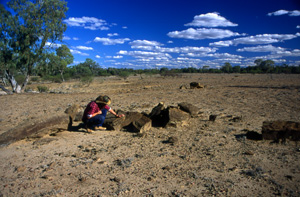Field work and exploration

of Winton Formation sandstone in the
channel country near Isisford,
central-western Queensland.
Photo: Steve Salisbury.
The rocks of the Winton Formation crop out over an area that is larger than all of the United Kingdom. Much of this land is uninhabited or extremely remote, and most of the rock in which the fossils occur is badly weathered. In addition, the country is exceedingly flat, and many of the geographical features that normally help to expose dinosaur fossils in other areas (such as hills and river systems, both of which aid erosion) are few and far between.
Finding fossils in this type of country is extremely difficult, and in order to have any success Dr Salisbury and his team have needed to work closely with local landholders and shire councils. More often then not, discoveries commence with a call from an inquisitive farmer who has discovered something he or she thinks is significant. These leads are then followed up, and if they prove to be worthwhile, further exploration in the area might be planned. The discovery of Elliot the sauropod, Australia's largest dinosaur, is a classic example.
In April 2003, Dr Salisbury and his team began searching the channel country around Isisford, central-western Queensland, in an attempt to find more fossil localities. Once again, Land Rover Australia helped out by providing the team with a Defender Td5 Extreme. Isisford Shire Council also helped out with valuable logistical assistance. The results of this exploration campaign will be announced shortly.
Fieldwork documentation and analysis
Data associated with each of the new fossil sites and the fossils they contain is being recording in a GIS-based Digital Palaeontology Support System, designed by Dr John Hayes, (School of Design and Built Environment, Queensland University of Technology). For further information on the Digital Palaeontology Support System, click here.
